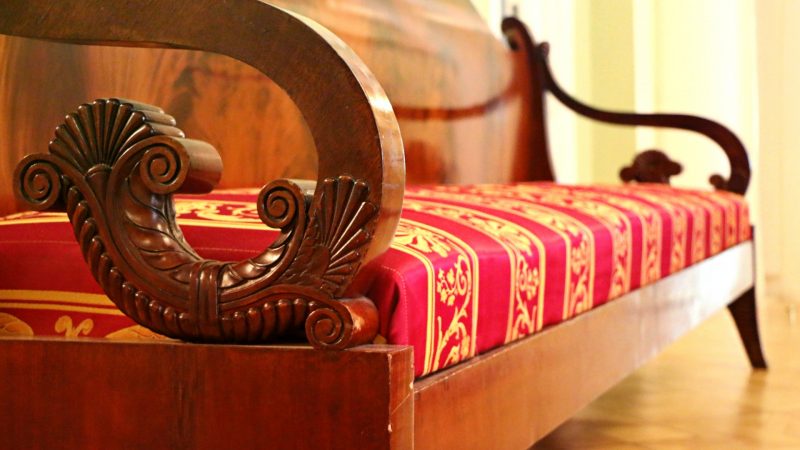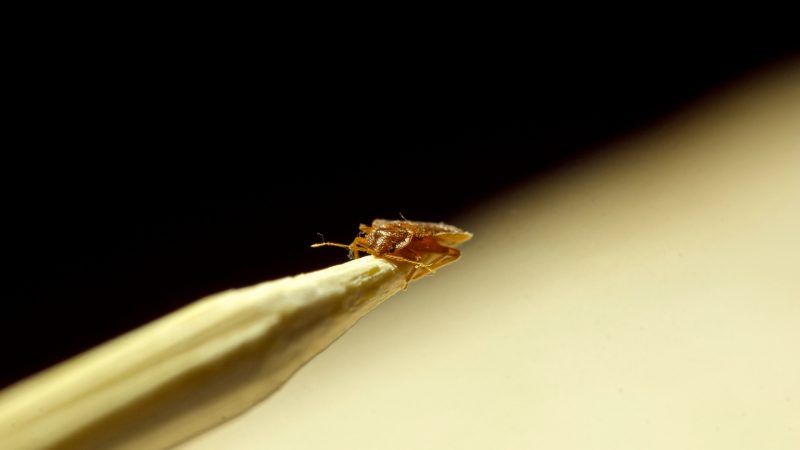Although they can live in your bed, clothes, and carpets, bed bugs can also live in any tiny holes in our homes. Admittedly, every home have those which makes them that more vulnerable to bed bugs.
Bed bugs can live in wood, but they can’t burrow in wood. For example, if a certain piece of wooden furniture has a hole in it, bed bugs can use it to hide inside. Still, they always prefer to live in mattress or bedding, rather than wood.
A wooden frame of bed, for example, is a great place for them to hide while they are not feeding. Wooden bed frame is close to the mattress and bedding, right? This is why bed bugs will infest wooden frames and wooden floors but will remain wherever their host is near.
Can Bed Bugs Live in Wood Furniture?

Of course, bed bugs can live in wood furniture. Couches are the most vulnerable when it comes to bed bug attacks and of course, their construction is made of wood. If it’s an old couch, chances are that there are holes in the wooden construction AND the mattress.
In most cases, wooden constructions have tiny holes where the bugs can hide. Remember that even the smallest crack inside the construction is enough for several bed bugs to pass through.
Thanks to their flat body, bed bugs can fit almost everywhere and the hole needs to be as wide as the thickness of your credit card!
Can Bed Bugs Live in the Wood Floor?
Older parquet floors are much more prone to bed bug infestation because the wood tends to deteriorate after a certain time, especially if it’s abused.
Although these cracks in the floor allow bed bugs to lay eggs, once again, this will not be their first choice. Bed bugs prefer a dark and obscure place to hide, live and lay eggs and your floor isn’t one of those places.
Are Bed Bugs Attracted to Wood?

Bed bugs seek hiding places based on the visibility (or the lack of it) and lower temperatures. As far as the material goes, they don’t care about that, meaning that bed bugs are not attracted towards the wood.
Do Bed Bugs Lay Eggs on Wood?
Bed bugs will not lay eggs directly on the wooden surface. Instead, they look for cracks in wood, they hide in there and lay eggs while doing so. Although we mentioned that bed bugs could technically lay eggs in cracks of your wooden floor, it’s unlikely to happen.
They don’t have any preference towards the wood and as long as the surface is nice and dark, that’s where they’ll lay eggs.
Can Bed Bugs Burrow into Wood?
Bed bugs can’t burrow in wood because they don’t have the typical jaws for burrowing. Instead, they have a so-called drinking straw, just a tiny fascicle for feeding.
Our homes have so many tiny cracks that it’s impossible to conceive. Thanks to those cracks, bed bugs can find their new home without much hassle and without needing to burrow. If it weren’t for holes and cracks, bed bugs would have no place to live and lay eggs, meaning that they wouldn’t exist in a large number.
If you find that your wooden bed or floor has been burrowed, know that those aren’t bed bugs. It’s most likely carpenter ants, termites, and some sorts of beetles.
Can Bed Bugs Eat Through Wood?
Bed bugs feed strictly on blood. Since they don’t have jaws that can chew through materials, bed bugs, even if they would want, couldn’t eat through wood. They can’t eat through anything, being it fabric, wood or something softer.
Bat bugs evolved into bed bugs and bat bugs still live in caves. They didn’t have to bite through anything to create their space for living and neither do bed bugs.
Can Bed Bugs Live in Cedarwood?

Anecdotal evidence suggests that cedarwood can help to repel bed bugs but no scientific proof exists. Cedar oil, due to its concentration is excellent for repelling and killing bed bugs. This means that bed bugs could still live in cedarwood if there’s a crack in the particular furniture made of that type of wood.
Signs of Bed Bugs on Wood
Signs of bed bugs in wood include nothing more than bed bugs themselves. You see them and you know that they’re lingering around that piece of furniture. Other signs might include bed bug feces and eggs in various cracks and harborages.
How to Remove Bed Bugs From Wood Furniture – Step by Step Instruction
Method 1 – Use Pesticides
Step 1 – Use the vacuum cleaner to vacuum the bed bugs from the wooden surface.
Step 2 – Use the steamer to kill the remaining bed bugs, if there are any of them left.
Step 3 – Put on your fumigation mask.
Step 4 – If you have a parquet floor, remove the carpet and spray the pesticide in the cracks. If it’s your wooden bed that’s infested, remove the mattress and bedding, spray the entire bed construction with bed bug spray this includes cracks and even your mattress without bedding.
- KILLS BED BUGS, EGGS & LARVAE FAST - Plant-powered bed bug...
- MAX-STRENGTH BED BUG PROTECTION - Bed Bug Patrol bed bug killer...
- UNIVERSITY TESTED & FIELD PROVEN - Fully entomologist...
- 100% AMERICAN QUALITY - Since 2003, we are a small family-owned...
- INGREDIENTS: Active Ingredients: Clove Oil (0.03%), Peppermint...
Step 5 – Wait for the pesticides to dry up.
Step 6 – Additionally, you can spray the surfaces once again and when you do that, wait for them to dry again.
Step 7 – You can now use your wooden furniture/floor.
Method 2 – Utilize Floor Barriers
Floor barriers are great for preventing bed bugs from entering tiny cracks in your floor.
- Spray around your wooden floor.
- Clean the cracks thoroughly and spray additional pesticide inside.
- Use wood putty to fill up every crack and prevent bed bugs from entering inside.
Method 3 – Use Bed Bug Interceptors
Step 1 – Bed bug interceptors are great for preventing bed bugs from getting in your bed. Place each interceptor around the feet of your bed.
Step 2 – You can leave them like that or you can fill them with water, in which case the bed bugs will drown.
Step 3 – Leave the interceptors for a day or two and pay attention if bed bugs have been caught.
Step 4 – If there are dead or alive bed bugs inside, use hot water to drown them or throw away the interceptors.
Method 4 – Heat Treatment
Because heat treatment requires an exterminator, there aren’t any steps for this method. Methods we’ve mentioned above can help us get rid of most bed bugs and in some cases all of them but exterminators can clean your house of bed bugs in a matter of a day or two.
For wooden surfaces, heat treatment might be the safest and the most efficient method.
Of course, since you’re going to pay for it, you will not save any cash but that’s okay because getting rid of bed bugs should be your top priority.
How to Treat Wood for Bed Bugs – The Best Products
1. Bed Bug Interceptors
- SLEEP EASY! 24/7 BEDBUG DETECTION AND PROTECTION — Easily...
- EFFECTIVE, HEAVY DUTY, VERSATILE DESIGN — Eliminate your...
- USE UNDER BED POSTS AND FURNITURE LEGS — In addition to use in...
- BED BUGS CLIMB IN BUT CANNOT CLIMB OUT — Bed bugs can easily...
- PACK OF 8 — Each box includes a set of eight bed bug...
Bed bug interceptors are perhaps one of the most reliable products for killing bed bugs. The package includes 8 bed bug traps, viable for two beds in your home and to be honest, these are more affordable than ever.
Since these traps are black, they are not that visible and don’t ruin the aesthetics of your bed. But also because of that color, bed bugs are easier to spot when they get trapped inside.
2. Bed Bug Patrol Bed Bug Killer – 100% Natural
- KILLS BED BUGS, EGGS & LARVAE FAST - Plant-powered bed bug...
- MAX-STRENGTH BED BUG PROTECTION - Bed Bug Patrol bed bug killer...
- UNIVERSITY TESTED & FIELD PROVEN - Fully entomologist...
- 100% AMERICAN QUALITY - Since 2003, we are a small family-owned...
- INGREDIENTS: Active Ingredients: Clove Oil (0.03%), Peppermint...
This pesticide is great for killing bed bugs on contact and since it’s a natural formula, it’s completely safe for you and your family. Bed Bug Patrol also made sure to add a very pleasant peppermint and clove scent, so you don’t have to suffer while treating your wooden floor from bed bugs.
If you’re worried about stains on your wooden surface, the manufacturer ensures us that it’s stain-free, which is great for using on more exposed surfaces.
The versatility of this product doesn’t stop there, as you can also use it on mattresses and sheets. This will ensure that no bed bug remains alive and that you can continue with your life with happiness and enjoyment, at least when it comes to worrying about bed bugs.
Bed Bug Marks on Wood: How to Clean Bed Bug Feces on Wood
In case of mattress or bedding infestation, you can get rid of bed bug feces by steaming and washing the bedding. This is a simple solution for eliminating stains out of your bed.
When it comes to wooden surfaces you can use steamer to make the stains softer and easier to remove but we suggest another method that includes hydrogen peroxide and ammonia.
Hydrogen peroxide can lighten the color of the bedding or any type of fabric but can’t damage wood, which is why we suggest it. You can spray a bit of hydrogen peroxide and ammonia on a piece of wood and use your cloth to wipe it off.
If feces were there for some time, they might harden, and removing it can be a bit problematic, in which case this method works the best. In some cases, if it’s fresh, you can use wet tissues to wipe it easily.
List of Sources
Controlling Bed Bugs by Hand, University of Minnesota
Wang C., Cooper R., Cost-Effective and Money-Wasting Bed Bug Control Methods, The State University of New Jersey
Koehler PG, Pereira RM, Pfiester M, Hertz J. (July 2011). Bed bugs and blood-sucking conenose. EDIS. (26 April 2017)
Schuh R, Slater JA. 1995. True Bugs of the World (Hemiptera : Heteroptera) Classification and Natural History. Cornell University Press, Ithaca, New York.
- How to Get Rid of Copperheads | Practical Guide - August 27, 2023
- How to Get Rid of Corn Snakes | What Makes Them Aggressive? - August 27, 2023
- How to Get Rid of Alligators | Safety Measures and Removal Methods - July 16, 2023


